
Harvard Yard, in Cambridge, Massachusetts, is the oldest part of the Harvard University campus, its historic center and modern crossroads. It contains most of the freshman dormitories, Harvard's most important libraries, Memorial Church, several classroom and departmental buildings, and the offices of senior University officials including the President of Harvard University.

The New England Conservatory of Music (NEC) is a private music school in Boston, Massachusetts. The conservatory is located on Huntington Avenue along the Avenue of the Arts near Boston Symphony Hall, and is home to approximately 750 students pursuing undergraduate and graduate studies, and 1,500 more in its Preparatory School and School of Continuing Education. NEC offers bachelor's degrees in instrumental and vocal classical music performance, contemporary musical arts, composition, jazz studies, music history, and music theory, as well as graduate degrees in collaborative piano, conducting, and musicology. The conservatory has also partnered with Harvard University and Tufts University to create joint double-degree, five-year programs.

Massachusetts Hall is the oldest surviving building at Harvard College, the first institution of higher learning in the British colonies in America, and second oldest academic building in the United States after the Wren Building at the College of William & Mary. As such, it possesses great significance not only in the history of American education but also in the story of the developing English Colonies of the 18th century. Massachusetts Hall was designed by Harvard Presidents John Leverett and his successor Benjamin Wadsworth. It was erected between 1718 and 1720 in Harvard Yard. It was originally a dormitory containing 32 chambers and 64 small private studies for the 64 students it was designed to house. During the siege of Boston, 640 American soldiers took quarters in the hall. Much of the interior woodwork and hardware, including brass doorknobs, disappeared at this time.

Central Methodist University is a private university in Fayette, Missouri. CMU is accredited to offer master's, bachelors, and associate degrees. The school is affiliated with the United Methodist Church.

The Lyman School for Boys was established by the Commonwealth of Massachusetts in c. 1884 and operated until c. 1971. The institution opened following the closure of the State Reform School for Boys in Westborough. The school was named for its principal benefactor, philanthropist Theodore Lyman, who served as mayor of Boston, Massachusetts from 1834 to 1836. The property is listed in the National Register of Historic Places.

The Nathaniel Topliff Allen Homestead is a historic house at 35 Webster Street in the village of West Newton, in Newton, Massachusetts. The Greek Revival house is notable as the home of Nathaniel Topliff Allen (1823–1903), an innovative educator in the mid-19th century. Allen's pioneering work influenced the development of new teaching methods taught at the state normal school. The house is listed in the National Register of Historic Places, and is currently owned by Newton Cultural Alliance.
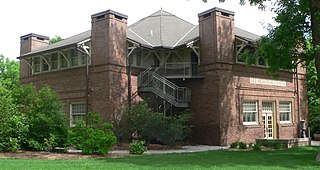
The Doane College Historic Buildings are located on the Doane University campus at 1014 Boswell Avenue in Crete, Nebraska, United States. Listed on the National Register of Historic Places as a historic district, there are three buildings included: Gaylord Hall, Whitcomb Conservatory/Lee Memorial Chapel, and Boswell Observatory.

The Peter Faneuil School is an historic school building at 60 Joy Street on Beacon Hill in Boston, Massachusetts. It is a four-story brick Tudor Revival building with limestone trim, built in 1910 to designs by the Boston architect James T. Kelley and his associate, Harold S. Graves. It is named for Peter Faneuil, the benefactor who gave Faneuil Hall to the city.

The Boston Consumptives Hospital is a historic tuberculosis hospital in the Mattapan neighborhood of Boston, Massachusetts. It consists of a complex of eighteen historic buildings on 52 acres (21 ha) of land. Most of these buildings were built between 1908 and 1932, although the Superintendent's House predates the hospital's construction; it is an Italianate house built c. 1856. They are predominantly brick buildings that are Colonial Revival in character, although the 1929 main administration building has a variety of different revival elements. Several of the buildings on the campus—The Administrative or Foley Building; The Doctor's Residences, Dormitories and Wards; and The Power House—were designed by the renowned architectural firm Maginnis and Walsh. The complex was the largest tuberculosis hospital in the state, built in response to reports that the disease was responsible for more deaths than any other in the city. The facility was used for the treatment of tuberculosis through the middle of the 20th century, and then stood largely vacant until 2002, when plans were laid to rehabilitate the property for other uses.
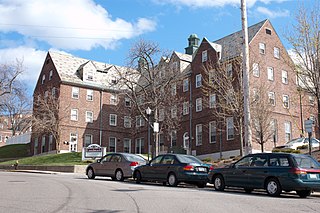
The Edward H. Haskell Home for Nurses, also known as the New England Baptist Hospital Training School For Nurses, is a historic academic complex in the Mission Hill neighborhood of Boston, Massachusetts. Its original building, a 1-1/2 to 2+1⁄2-story brick-faced wood-frame building, was designed by Edward Sears Read in the Jacobethan style and built in 1922. This building originally housed a dormitory and classrooms. In 1931 a large wing gave the building an L shape, and another series of additions in 1940 gave the complex its present appearance, surrounding a courtyard atop Parker Hill. The complex was converted into an assisted-living facility in 2002.

Bertram Hall at Radcliffe College is an historic dormitory building on the Radcliffe Quadrangle of Harvard University at 53 Shepard Street in Cambridge, Massachusetts. Built in 1901, it was the first dormitory building constructed for Radcliffe College. The building is now one of the dormitories of Harvard's Cabot House. It was listed on the National Register of Historic Places in 1986.

Ware Hall is an historic residential apartment building at 383 Harvard Street in Cambridge, Massachusetts. It was designed by local architect George Fogerty and built in 1893. Fogerty was also the architect of Claverly Hall, a similar building, on Mount Auburn Street. This five story brick Classical Revival building is a rare example of an apartment house built in Mid Cambridge that was designed to cater to Harvard University students. Apartment blocks of this quality were generally built closer to the Harvard campus, so this one stands out when compared to other apartment house in its immediate surroundings.
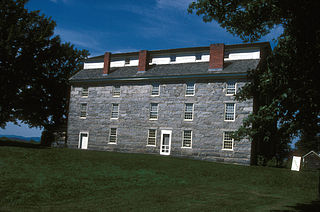
The Brownington Village Historic District is a historic site in Brownington, Vermont, United States. It is located near the intersection of Hinman and Brownington Center roads. It was added to the U.S. National Register of Historic Places on June 9, 1973. The district consists of five buildings within the Old Stone House Museum complex and three neighboring houses, dating from the early 19th century.

The Nathaniel Thayer Estate is a historic house in Lancaster, Massachusetts. Built in 1846 and extensively restyled in 1902, it is a particularly fine example of Georgian Revival architecture, and was added to the National Register of Historic Places in 1976. Since 1946, the estate has been owned by the Seventh-day Adventist Church, which operated Atlantic Union College there until its 2018 closure. The main house is presently home to Thayer Conservatory, bringing community together through music and the arts.

The Castle, also known as Usen Castle, is a historic building at 415 South Street in Waltham, Massachusetts. The Medieval style structure, built in the style of a Norman castle in 1928, stands on the campus of Brandeis University, where it served as a dormitory until 2017. The building, the design of which is unlike any other on the campus or in the city, was listed on the National Register of Historic Places in 1979.
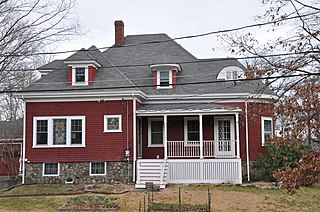
The House at 2 Nichols Street in Wakefield, Massachusetts, is a well-preserved, architecturally eclectic house built in the 1890s. The 1+1⁄2-story frame house has elements of the Tudor Revival, Queen Anne, and Shingle styles, and is one of two identical houses built by local builder Berndt Heurlin. It has a hip roof, but transverse gables, one of which has a rounded bay, giving it a Queen Anne feel. The foundation exterior is fieldstone, and there are several stained glass windows.

Franklin Hall in Goodwell, Oklahoma, USA, built during 1909-10 by a local contractor, has been used in various ways for housing throughout its history. It was listed on the National Register of Historic Places listings in Texas County, Oklahoma in 2007 with the alternate name Girls' Dormitory/Boys' Dormitory.
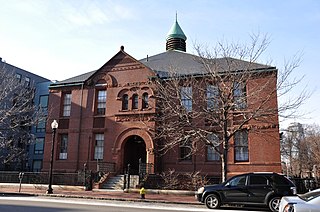
The Joshua Bates School is a historic school building at 731 Harrison Avenue in the South End neighborhood of Boston, Massachusetts. The 2+1⁄2-story Romanesque Revival brick building was designed by Arthur H. Vinal and built in 1884. It was named for financier and major benefactor of the Boston Public Library Joshua Bates. The school was closed in 1975 as a consequence of court-ordered desegregation actions. It was rehabilitated and adapted for use as artists' studios in 2003.

The Atlantic Heights Development is a historic company-built worker subdivision in Portsmouth, New Hampshire. Bounded by I-95, the Piscataqua River, and the tracks of the Boston and Maine Railroad, this small neighborhood was built in 1918–1920 to meet housing demand for workers at the Atlantic Company Shipyard, located just to the south, and served as a prototype for later residential subdivisions. It was listed on the National Register of Historic Places in 2006.

Fort Hill is a 0.4 square mile neighborhood and historic district of Roxbury, in Boston, Massachusetts. The approximate boundaries of Fort Hill are Malcolm X Boulevard on the north, Washington Street on the southeast, and Columbus Avenue on the southwest.























